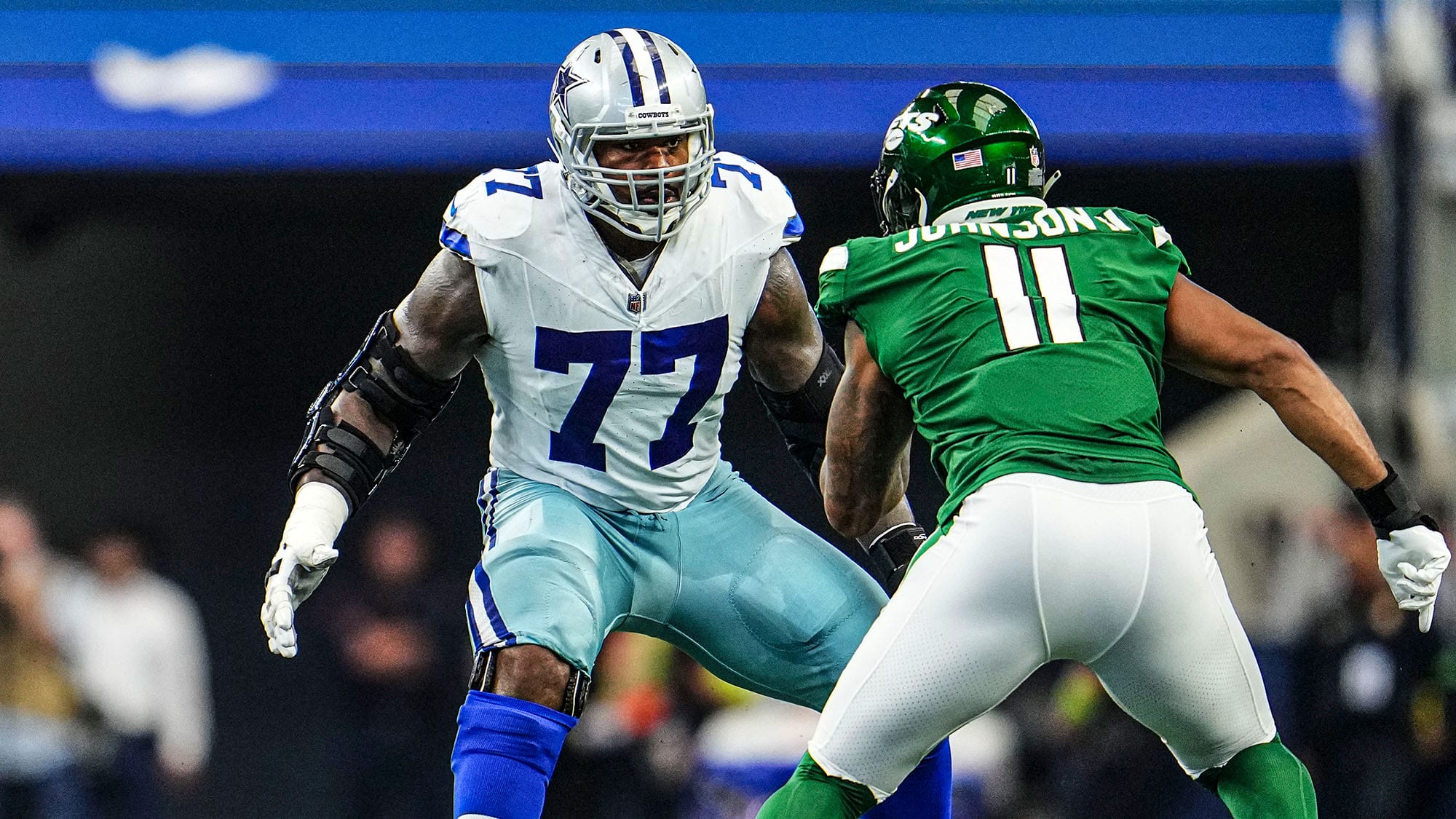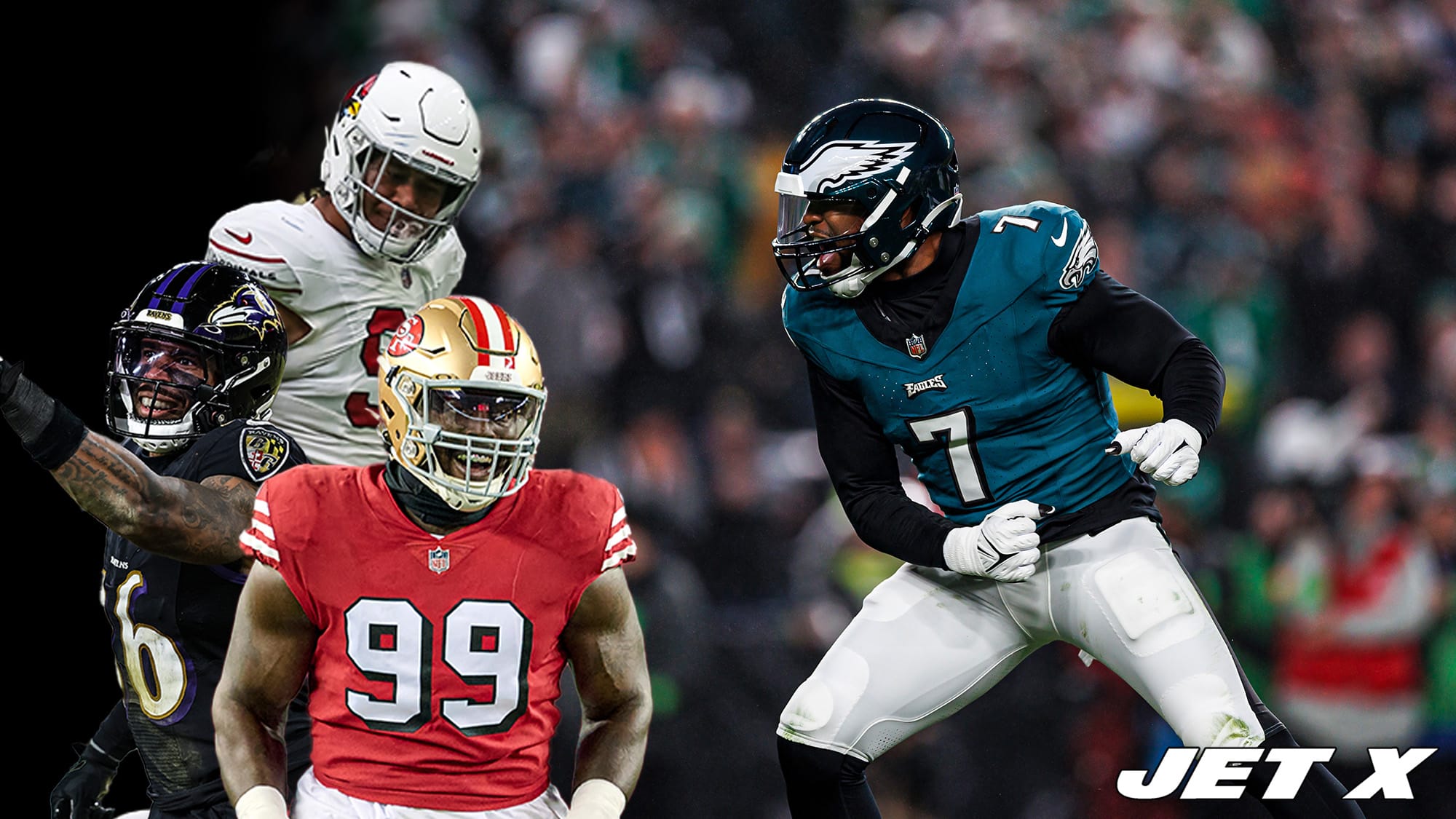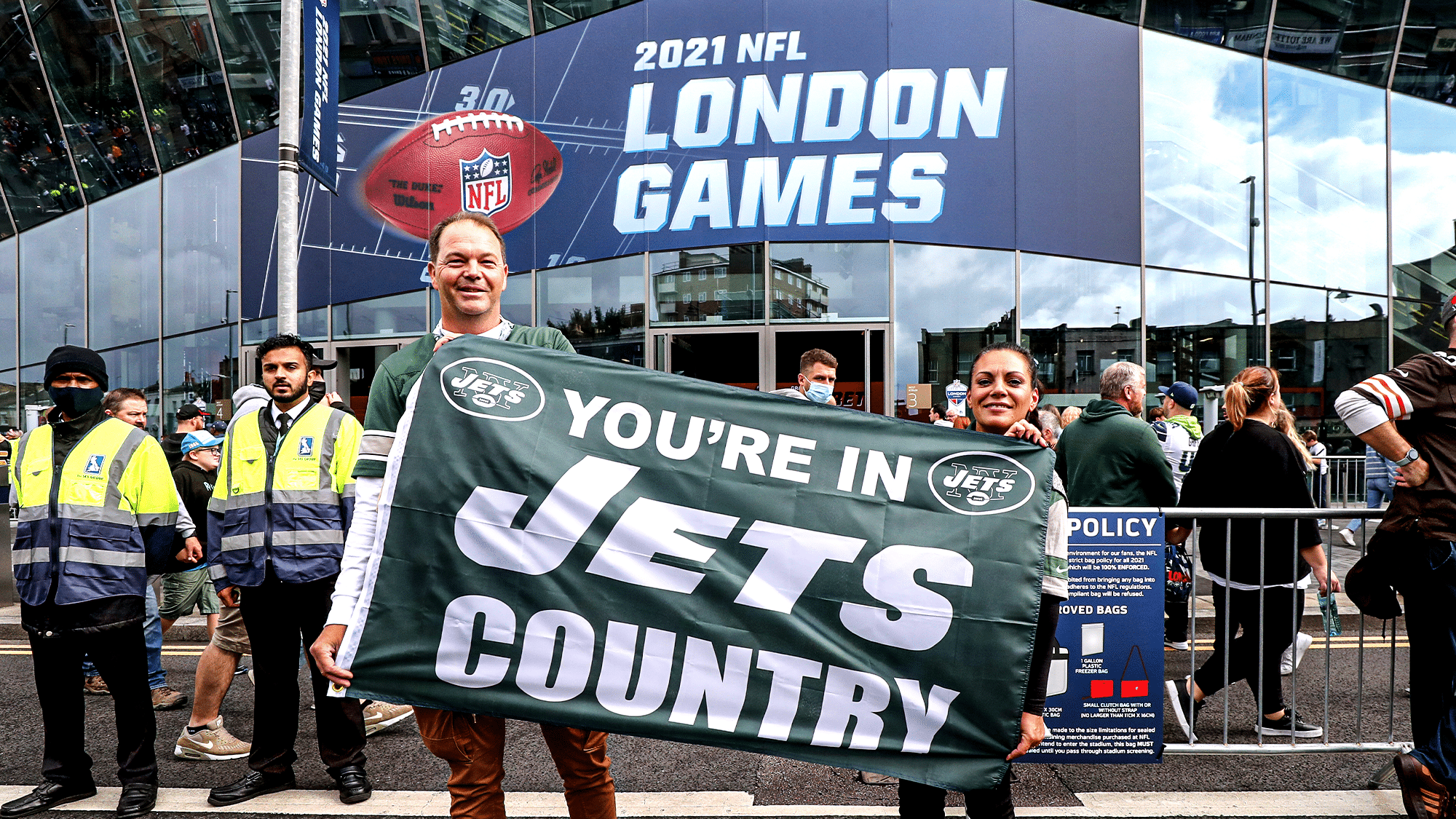The New York Jets just added the most dominant left tackle in team history
The above sentence is no slight to New York Jets legend D’Brickashaw Ferguson, who was an absolute stalwart for the team. Nor is it a slight to fellow Jets legend Winston Hill, a Pro Football Hall of Famer.
It’s just a fact: Tyron Smith is the most talented left tackle the Jets have ever had.
Smith is coming off his fifth career All-Pro appearance, being named to the second team. Ferguson and Hill had one combined All-Pro appearance in their careers (earned by Hill). Considering how undeniably excellent both players were for the Jets, it only goes to show how truly extraordinary Smith is.
Despite his immense talent, Smith’s contract is only for one year with $6.5 million guaranteed, per ProFootballTalk. Smith can earn $13.5 million more through incentives, making the deal worth up to $20 million.
Initial indications of the Tyron Smith deal: $6.5 million guaranteed with another $13.5 million to be earned based on playing time and other incentives. That’s why the Jets were surprised he took the offer.
— ProFootballTalk (@ProFootballTalk) March 16, 2024
What are the Jets getting in their new superstar offensive lineman? Let’s break down everything there is to know about his game.
Basic info
- Age: 33.2
- Height: 6-foot-5
- Weight: 320 pounds
- Hometown: Moreno Valley, CA
- College: Southern California
- Experience: 13 years (Drafted Round 1, Pick 9 by Dallas in 2011)
- Teams: Cowboys (2011-present)
- Previous contract: 8 years, $97.6M (Signed with Cowboys in July 2014)
Measurables
Smith’s incredible athleticism is one of his best attributes. He was a freak coming out of USC, helping him become a top-10 pick.
- Data from 2011 Combine (via Mockdraftable)
- Percentiles among all-time offensive tackle prospects
- Height: 6’5″ (30th percentile)
- Weight: 307 pounds (28th)
- Arm length: 36.375in (97th)
- Hand size: 11in (95th)
- 40-yard dash: 5.08s (82nd)
- Bench press: 29 reps (82nd)
Smith also tested at his pro day, where he posted a 109-inch broad jump, 31-inch vertical, 4.68-second shuttle, and 7.47-second three-cone. He also improved his forty time to 4.93 seconds. Overall, Smith earned a Relative Athletic Score (RAS) of 9.68/10.

As we’ll see when we look at some clips later on, Smith has lost very little, if any of this athleticism. Even at 33 years old with a heavy toll of injuries on his body, his movement skills pop off the screen when you watch him.
Arguably the best pass blocking tackle in the NFL
Jets fans, let’s be clear here: You are getting a megastar at a premium position.
Smith was at or near the top of the leaderboard among all tackles in just about every pass blocking metric.
Smith allowed just 18 total pressures on 536 pass-blocking snaps, per Pro Football Focus, giving him a pressure rate of 3.36%. This ranked third-lowest among 83 qualified tackles (min. 200 pass-blocking snaps), trailing only Penei Sewell and Terron Armstead. Among left tackles, only Armstead beat Smith.
Smith also earned the highest pass blocking grade among tackles at PFF (87.3) and had the fourth-lowest blown pass-block rate at Sports Info Solutions (2.0%).
Since these metrics all track different things and tend to spit out vastly different conclusions, it’s smart to agglomerate them to get a more accurate evaluation. Smith’s average ranking of 2.7 across pressure rate (3rd), PFF pass blocking grade (1st), and SIS blown pass block rate (4th) was the best among all tackles, putting him ahead of some star-studded company in the top 10:
- 1. Tyron Smith: 2.7 (3rd pressure rate, 1st pass-block grade, 4th SIS)
- 2. Tristan Wirfs: 4.0 (4th, 6th, 2nd)
- 3. Terron Armstead: 5.0 (1st, 13th, 1st)
- 4. Laremy Tunsil: 5.0 (7th, 3rd, 5th)
- 5. Kolton Miller: 8.3 (8th, 7th, 10th)
- 6. Penei Sewell: 10.7 (2nd, 15th, 15th)
- 7. Trent Williams: 10.7 (12th, 10th, 10th)
- 8. Rashawn Slater: 12.3 (23rd, 5th, 9th)
- 9. Andrew Thomas: 12.7 (15th, 16th, 7th)
- 10. Cam Robinson: 13.3 (10th, 17th, 13th)
Smith was extremely impressive at preventing costly pressures. Of his 18 allowed pressures, 16 were hurries. He gave up just one sack and one hit. His 0.37% sack-plus-hit rate was third-best among all tackles and second-best among left tackles (again behind Armstead).
The cherry on top of all these gaudy stats is the fact that Smith pulled it off while handling one of the toughest jobs of any left tackle in football. According to NFL Next Gen Stats, 84.5% of Smith’s pass-blocking snaps were one-on-one, the third-highest rate among left tackles. So, he was utterly dominant even with the Cowboys giving him help less frequently than nearly every left tackle in the league.
Smith is a technical wizard in pass protection. One of his signature moves is the snatch/trap technique, where he baits the defender into his extending his arms, swats them down, and then drops the defender into the ground. Here are two examples of Smith pulling it off against the 49ers.
Let’s watch Tyron Smith vs. the 49ers
This is the most talented left tackle the Jets have ever had. pic.twitter.com/ZgfpQHas8s
— Michael Nania (@Michael_Nania) March 16, 2024
Snatch/trap yet again
Guy is a pass blocking wizard pic.twitter.com/fowOEDAgZm
— Michael Nania (@Michael_Nania) March 16, 2024
One of the major reasons for Smith’s trustiness in one-on-one situations is how much ground he is capable of covering. Smith is explosive out of his stance and has quick, smooth feet. He gets outside to widely aligned edge rushers in a hurry and matches them all the way.
He’s very quick out of his stance and can cover a lot of ground in his sets. You can trust him to take on wide-9 rushers by himself. pic.twitter.com/MeEDRywyKn
— Michael Nania (@Michael_Nania) March 16, 2024
— Michael Nania (@Michael_Nania) March 16, 2024
Having a left tackle who can dominate in pass protection without help is a major asset for the offense. For one, it can allow the Jets to consistently shift their RB and TE help to other linemen who will probably need it more often than Smith. They can trust Smith to win on an island no matter who he is up against, giving them freedom to overload help to Morgan Moses’ side.
It can also allow the Jets to decrease the total number of pass-block snaps for their RBs and TEs, allowing them to be sent downfield on routes more frequently. This helps the offense gain a numbers advantage against the secondary on a more consistent basis.
If you have to leave your RBs and TEs in to block too often, the passing game could struggle due to the lack of threats being sent down the field relative to the number of defenders in coverage. This was a problem for the Jets in 2023. Their offensive line was so awful that they were often forced to keep two skill-position players in to block, leaving them consistently outnumbered downfield since only three players ran routes.
The trickle-down effect of an elite pass blocking left tackle is remarkable. It’s a benefit the Jets have not enjoyed since D’Brickashaw Ferguson’s heyday. And I’d argue that a healthy Smith is even more unbeatable than Brick was at his peak, which is saying a lot.
Smith is a transformative addition to the Jets’ passing game.
Good run blocker and an excellent fit in the Jets’ revitalized scheme
Smith’s run blocking is not quite as special as his pass blocking, but he remains highly regarded in that phase.
The metrics are all over the map. ESPN’s run-block win rate loved him, placing him fourth among tackles at 79% in 2023. The site doesn’t list how many players are qualified (it only shows the top 10), but if we used the same group of 83 qualified tackles as before (min. 200 pass-block snaps), it would put Smith at the 96th percentile.
PFF’s run blocking grade placed him 25th out of 83 tackles (71st percentile) with a 70.5 grade. Sports Info Solutions’ blown run block rate saw him as mediocre, placing him 39th out of 67 qualifiers (42nd percentile) at 2.4%.
Between the three metrics, Smith’s average percentile ranking was 70th. Pretty darn good as a complement to league-best pass blocking.
Most importantly, Smith projects as a fantastic fit in the Jets’ apparent mission to convert into a gap blocking scheme. New York’s additions of former Ravens starters John Simpson and Morgan Moses strongly signaled that the team is likely seeking to change its philosophy in the run game, and Smith doubles down on that.
In 2023, Smith earned an 80.9 gap blocking grade at PFF, ranking third-best among tackles. His zone blocking grade was 59.6, placing 61st. He fits right into the downhill, power-running mentality that New York is seemingly trying to establish.
The film backs up what the grades are saying. Smith displays tremendous gap blocking traits when you watch him. In particular, he is a phenomenal puller – giving the Jets yet another one after already having four in place. I’m not sure where the Jets’ offensive line will end up ranking overall, but I feel pretty comfortable saying that they are a serious contender for the best pulling offensive line in the NFL.
Smith still has much of the athleticism that he had when he got drafted. Watch him explode into the open field on these pulls.
The Jets got YET ANOTHER good puller… shoves this guy from the numbers to the sideline in one shot pic.twitter.com/DVNUbDauBl
— Michael Nania (@Michael_Nania) March 16, 2024
Jets probably have the best group of pullers in the NFL. pic.twitter.com/C8yEDpinC6
— Michael Nania (@Michael_Nania) March 16, 2024
Here is an example of Smith executing a down block to open a hole on a gap concept.
Wouldn’t post those grades without clips to back it up…
Check out Tyron here pic.twitter.com/jy0z41WaWR
— Michael Nania (@Michael_Nania) March 16, 2024
And here is Smith creating tremendous vertical movement on a double team against Quinnen Williams.
Look at the movement Tyron Smith gets on the double team vs. Quinnen Williams here
Jets are going to MAUL teams in the power run game. pic.twitter.com/zvele0JnHa
— Michael Nania (@Michael_Nania) March 16, 2024
The Jets are built to maul opponents in the power run game.
Chronic injury history
Smith is one of the most injury-prone players you will ever see in the NFL. He is essentially guaranteed to miss at least three games, which is why he could only land an incentive-laden one-year deal with $6.5 million guaranteed despite his all-world talent.
The beginning of Smith’s career went smoothly, as he only missed one game through his first five seasons. Ever since 2016, though, the injuries have been constant.
Over the past eight seasons, Smith has missed 49 games, which is an average of 6.1 games per year. He’s played 62.6% of the Cowboys’ regular season games over this span, which is about 10.6 games in a 17-game season.
The frequency of Smith’s injury problems is an even greater issue than his total number of missed games. It’s not as if one or two serious injuries are responsible for the majority of the games he has missed. Rather, his unavailability is largely due to the accumulation of many minor injuries. Smith has missed at least three games in eight consecutive seasons. He last played more than 13 games in 2015.
Most of Smith’s career injuries have been minor, but at 33 going on 34 years old, any injury could turn out to be serious, so it’s extremely alarming that he tends to get injured so frequently.
This past season alone, Smith missed games due to three different injuries. He missed two consecutive games from Weeks 3-4 with a knee injury, one game in Week 8 with a neck injury, and one game in Week 16 with a back injury.
Despite the trio of injuries, Smith’s 13 games played in 2023 were his most since 2019. He had only played 17 games from 2020-2022.
Smith missed the first 13 games of the 2022 season with a torn hamstring, returning for the final four regular season games and two playoff games.
Smith missed five games with an ankle injury in 2021, and those absences came over two separate stints. He was out from Weeks 9-11, returned to play three games, and left in the third game, leading to two more missed games.
In 2020, Smith played two games and then missed the final 14 games after having neck surgery during the season.
The 2016-2019 stretch saw Smith miss precisely three games each year. Over this period, he had ailments to his back (three separate injuries), knee (two separate injuries), neck, and ankle.
Fortunately for Smith, he’s largely avoided major injuries. His only major injuries across 13 NFL seasons were his 2022 hamstring injury (first 13 games) and 2020 neck surgery (14 games, season-ending).
Since most of Smith’s injuries are relatively minor, he plays the majority of the season more often than not. Smith played at least 11 games in six of the past eight seasons and at least 13 games in five of the past eight. He also tends to be ready by playoff time. Smith has never missed a playoff game in his Cowboys career, participating in all nine of Dallas’ playoff games since he was drafted (spanning over six playoff appearances).
There is no denying that Smith’s injury woes are a massive concern. This is especially true as he enters a season where he will turn 34 years old in December.
On the positive side of things, Smith has shown there is a good chance he will give you somewhere from 11 to 13 regular season games while being healthy for the playoffs. Having an elite left tackle for about three-quarters of the season is not the worst scenario in the world – as long as you have a good backup. That is the next crucial step for the Jets. Now that they’ve chosen to rely on Smith as a starter, they need to prioritize acquiring a backup who they trust to start at least four games.
The Jets and their fans will have to hold their breath any time Smith steps on the field. That’s the unfortunate reality of this signing. Still, the ceiling offered by Smith can hardly be higher, making the gamble worthwhile for a team that is trying to maximize a short-term Super Bowl window with Aaron Rodgers.
I and many others felt like the Jets needed to make an all-in move on the offensive side of the ball. This is it. Smith is the ultimate swing-for-the-fences signing. Joe Douglas will either go down swinging or he will knock it out of the park. Either way, give Douglas credit for rolling the dice in a situation where it makes all the sense in the world.













Great to have him and I’m thankful, but on the durability front, I’ll take Brick.